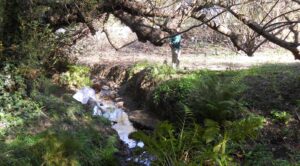In 2001, bulldozers excavated two immense old army water tanks that long sat at the edge of Mountain Lake, a two-and-a-half-acre lake in San Francisco’s Presidio that’s one of only three natural lakes in the city. That same year, native seedlings and cuttings were planted, a forest of more than 100 eucalyptus trees was removed, and yards of cyclone fence and invasive plants were pulled.
But what happened next surprised even the project’s plant specialists: Along the newly graded waterfront sprouted giant arrowhead (Sagittaria montevidensis), a plant not seen in San Francisco for over 50 years. The dormant seeds had likely lain buried under the cement water tanks, waiting for sunlight and a chance to grow again.
And grow they have. The lake’s restoration began in earnest only five years ago, yet already the lakefront blossoms with pink flowering currant, ceanothus, and sticky monkey flower. A large and diverse group of community restoration volunteers is also flourishing. In winter, school kids and seniors alike plant native seedlings; in summer, they weed and clear underbrush. Kitty Whitman is one of the many locals who volunteers regularly at Mountain Lake through the Presidio Park Stewards: “When you see a place that was once English ivy and eucalyptus blossom with hundreds of natives—when the place starts to look and smell like California—now that gets people interested.”
But why is there a lake in a landscape dominated by sand dunes? Just north of Mountain Lake, several low-lying hills made of bedrock are a good clue: The lake’s impermeable substrate, part of the Franciscan Formation, holds water in an otherwise porous dune field. That year-round fresh water has played an important role in the region’s history.
Spaniard Juan Bautista de Anza’s expedition provided the first written account of the lake. In 1775, his party set out from Sonora, Mexico, to San Francisco Bay. After camping along Mountain Lake, de Anza declared the site to be Spain’s northern-most presidio, or garrison. Pedro Font, who accompanied de Anza, described Mountain Lake: “abundant pasturage, plenty of firewood and fine water, all good advantages for establishing here the presidio . . . Here and near the lake there are yerba buena and so many lilies that I had them almost inside my tent.”
The lake looks vastly different today. It’s now constrained on its south side by a densely populated San Francisco neighborhood, and to its north by a golf course. Highway 1, here a busy four-lane thoroughfare, literally truncates the lake’s western flank. Runoff from the roadway pollutes the lake’s waters, and the lake bed contains a band of lead-tainted sediment from the days of leaded gasoline. Gone are the California red-legged frogs and western pond turtles, depleted, as local lore has it, by hungry Gold Rush—era settlers, and likely finished off by the lake’s toxic waters.
But through the determination of many local residents, the waters of this spring-fed lake may soon run clearer. In 2001, UC Berkeley graduate student Liam Reidy conducted pollen analysis of the lake’s sediment to determine its historical plant record. The pollen record shows, among other things, that red alder was prevalent along the lakeshore throughout the Spanish era, but disappeared by the mid-1850s, presumably depleted as a source of firewood.
Presidio Trust landscape architect Michael Boland, who has supervised the restoration, set out to reestablish red alder and other species that thrived in the past. His objective: to design an ecosystem that allows wildlife to thrive at the edge of the city. “Restoration does bump up against the urban setting,” he says. “Our goal was to restore as much riparian [habitat] as we could, while still allowing visitors direct access to the lake.”
Boland designated wetland and riparian species for the waterfront. But he tweaked the transitional areas slightly, aiming for something denser and more evergreen than would have existed historically, since the city has so few riparian areas. The solid evergreen community—oak woodland and coast scrub—helps create cover and minimizes disturbance of the wildlife along the riparian corridor. Reestablishing a wider variety of native plants not only looks good, it provides more habitat for the wildlife that live in the Presidio.
Boland already sees signs of success. “Now when you work on the site you hear birds, and you get buzzed by hummers. It’s animated differently by wildlife now that the woodland is growing and wildlife can live there without being disturbed.”
For information about getting involved in the restoration, visit the Friends of Mountain Lake Park’s web site at www.fmlp.org, or call the Park Stewards at (415)561-3034, ext. 3445.

.jpg)



